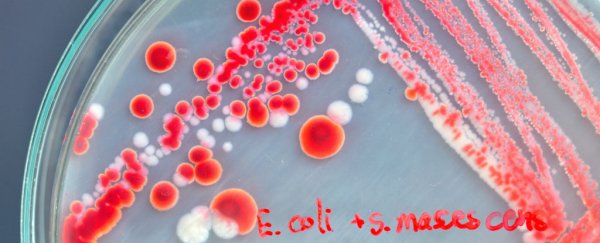You may have already heard about the growing problem caused by antibiotic resistance - the spread of superbugs that have evolved to become resistant to the antibiotics we usually attack them with. It's an issue that could have very serious implications for global health and disease if it isn't tackled urgently, and now researchers have made an important step in finding a solution.
A new study has discovered how these drug-resistant bacterial cells maintain a defensive barrier, and if further research can find a way to bring down these walls - rather than targeting the bacteria directly - the bacteria could be prevented from developing drug resistance in the first place.
Key to the discovery is a sophisticated piece of scientific equipment called the Diamond Light Source, which is capable of emitting intense beams of light to examine bacteria at an atomic level. In this case, it was used to study a particularly stubborn type of bacteria called gram-negative bacteria. Gram-negative bacteria cells have impermeable, lipid-based outer membranes that make them particularly resistant to antibiotics.
It's this membrane that scientists from the University of East Anglia in the UK focussed on, building on previous work where they managed to identify a specific weakness in the cell barrier. Now they've uncovered how the wall is built and maintained - a crucial step forward in working out how to eventually crack it.
"Beta-barrel proteins form the gates of the cell wall for importing nutrition and secreting important biological molecules," lead researcher Changjiang Dong explains. "The beta-barrel assembly machinery (BAM) is responsible for building the gates (beta-barrel proteins) in the cell wall. Stopping the beta-barrel assembly machine from building the gates in the cell wall cause the bacteria to die."
In the E.coli bacteria studied by Dong and his team, five subunits form a ring structure before using a 'rotation and insertion' mechanism to build up outer membrane proteins. Now that this complex BAM process has been revealed, it opens the way for next-generation drugs to be developed.
Because the mitochondria structures inside human cells are constructed in a similar way to the beta-barrel assembly machinery, the discovery could help us understand more about own own bodies as well, particularly with regards to diseases like Parkinson's (which appear when the mitochondria begin to break down).
"Our work is the first to show the entire BAM complex," says Dong, adding that targeting the BamA subunit could be a way of providing effective treatments to fight superbugs in the future.
The team's work has been published in Nature.
